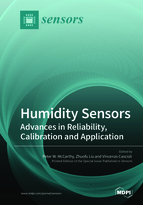Humidity Sensors: Advances in Reliability, Calibration and Application
A special issue of Sensors (ISSN 1424-8220). This special issue belongs to the section "Physical Sensors".
Deadline for manuscript submissions: closed (30 December 2018) | Viewed by 48128
Special Issue Editors
Interests: humidity sensor
Special Issues, Collections and Topics in MDPI journals
Interests: data analysis; signal measurement and detection; medical information processing
Special Issues, Collections and Topics in MDPI journals
Interests: evaluation of sitting comfort and discomfort; signal measurement at the user–seat interface
Special Issues, Collections and Topics in MDPI journals
Special Issue Information
Dear Colleagues,
Humidity detection has come a long way since the use of wet bulb psychrometry. Many electronic sensor-based methods are becoming available for detecting and reporting relative humidity. However, as one moves further away from the physical measurement of any property, the issues of reliability and accuracy of calibration become increasingly important. In the case of humidity, the property of the sensor that enables the measurement to be made can also be the property that can lead to problems with the calibration and sensitivity, as well as recovery of the sensor: all of which can limit uptake and application of the sensors.
The rapid recent growth in research aimed at finding the best method of sensing humidity is in proportion with the range of potential needs across a diverse series of fields from biomedical, agriculture, pharmaceutical to industrial such as in the semiconductor industry and food processing. Therefore, never has the need been greater for study and refinement of these sensors. We consider this a good point to bring together research into the uses (potential and actual) and look at the issues surrounding this measurement.
The aim of this Special Issue is to present some of the possibilities that humidity sensors offer, focusing on the different configurations that can be used and novel applications in any field. In addition, selected high quality papers from IFOST 2018 (http://www.ifost2018.org/IFOST2018/) will be invited for further consideration regarding publication in this Special Issue. Reviews presenting a deep analysis of specific problems such as calibration and use will also be considered.
We welcome original research papers and review articles on humidity sensor technology, their applications and comparison between types.
Prof. Dr. Peter W. McCarthyProf. Dr. Zhuofu Liu
Dr. Vincenzo Cascioli
Guest Editors
Manuscript Submission Information
Manuscripts should be submitted online at www.mdpi.com by registering and logging in to this website. Once you are registered, click here to go to the submission form. Manuscripts can be submitted until the deadline. All submissions that pass pre-check are peer-reviewed. Accepted papers will be published continuously in the journal (as soon as accepted) and will be listed together on the special issue website. Research articles, review articles as well as short communications are invited. For planned papers, a title and short abstract (about 100 words) can be sent to the Editorial Office for announcement on this website.
Submitted manuscripts should not have been published previously, nor be under consideration for publication elsewhere (except conference proceedings papers). All manuscripts are thoroughly refereed through a single-blind peer-review process. A guide for authors and other relevant information for submission of manuscripts is available on the Instructions for Authors page. Sensors is an international peer-reviewed open access semimonthly journal published by MDPI.
Please visit the Instructions for Authors page before submitting a manuscript. The Article Processing Charge (APC) for publication in this open access journal is 2600 CHF (Swiss Francs). Submitted papers should be well formatted and use good English. Authors may use MDPI's English editing service prior to publication or during author revisions.
Keywords
- Humidity sensor
- Calibration/reliability
- Moisture detection
- Temperature artefacts
- Nanomaterials
- High sensitivity structures, interferometers
- Rapid response
- Recovery rates
- Printed humidity sensors
- SPR/LMR/LSPR
- Miniature humidity sensors
- RFID
- Thermal compensation
- On-field application
- Embedded/wearable/mobile humidity sensors
- Wireless humidity sensors
- Medical/healthcare
- Food/environmental
- Humidity profile mapping







